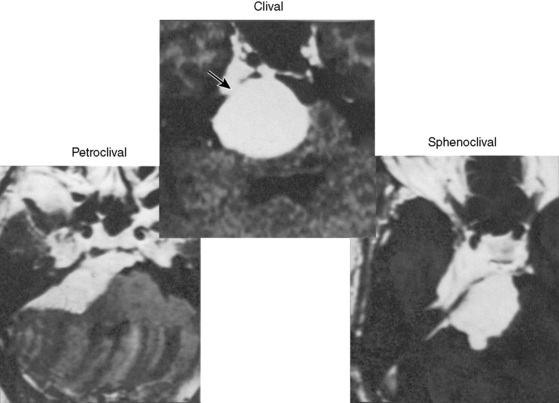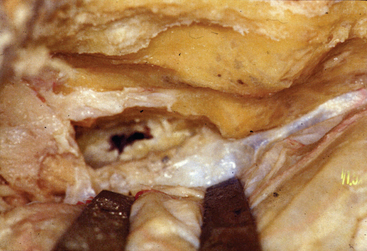CHAPTER 38 Petroclival Meningiomas
Middle Fossa Anterior Transpetrosal Approach
INTRODUCTION
Surgical removal of the pyramidal bone through the middle fossa has been used mainly for cerebellopontine angle tumors since 1970.1–6 Advantages of the approach were wider surgical exposure and minimal brain damage compared to the conventional subtemporal approach, because the tumor is accessed epidurally from the space of the resected pyramidal bone to spare brain retraction and sacrifice of the bridging veins. In 1977, the approach was applied to clival meningiomas.7 For petroclival meningiomas, a high tumor radicality was achieved because of removal of attached dura with the tumor. However, disadvantages were sacrificed hearing and risk of cerebrospinal fluid (CSF) rhinorrhea.
In 1985, limited bone resection only in the pyramidal apex, the anterior transpetrosal approach (APA), was introduced to preserve hearing in clipping of basilar trunk aneurysms8,9 and indicated for petroclival meningiomas in the 1990s.10,11 After 1999, other authors recommended this approach for petroclival meningiomas.12–14
CLASSIFICATION OF PETROCLIVAL MENINGIOMAS AND INDICATIONS FOR APA
The petroclival meningiomas were classified into three types based on the extension of the tumor attachment (Fig. 38-1): (1) pure clival type, (2) sphenoclival type (middle fossa extension), and (3) petroclival type (extension along the posterior pyramid). The APA was indicated for the first and second types. The indication should not be selected based on the tumor size, but on the attachment size. The APA may absolutely be indicated for a tumor located in the midline clivus with extension into Meckel’s cave or in the middle fossa, and in a case with the tumor attachment on the upper half of the clivus and medial to the internal auditory meatus (IAM).
SURGICAL TECHNIQUE AND AVOIDING COMPLICATIONS
The anatomy and the surgical technique are described in refs. 15 to 17.
Exposure and Resection of the Pyramid
The dura mater is dissected and elevated from the temporal bone using a hooked retractor. The arcuate eminence is recognized medial to the EAM. The MMA is coagulated and cut at the foramen spinosum, and the periosteal dura, adhesive to the greater superficial petrosal nerve (GSPN), is cut to preserve the nerve. Tumor feeders commonly seen around GSPN or in the bone groove on the pyramid are coagulated. The interdural dissection is extended on the mandibular nerve to reduce tension of the dura, and the trigeminal impression is observed on the petrous apex. The axis of the microscope is shifted anteriorly to overlook the petrous apex. The IAM is located slightly anterior to the arcuate eminence, at a depth of 7 mm from the bone surface. The height of the arcuate eminence varies in each case, and must be checked by bone-targeted computed tomography (CT) before surgery. A line of maximal bone resection with preservation of the auditory structures is shown in Figure 38-2.
Dural Incision and Opening Meckel’s Cave
In large tumors, the posterior fossa is filled with the tumor mass. Tumor feeders from the tentorium can be coagulated to reflect the anterior leaflet of the tentorium. The trochlear nerve is commonly encased by the tumor at the point of dural entrance. The course of the trigeminal nerve varies according to the tumor origin and is classified into the following three types:18









